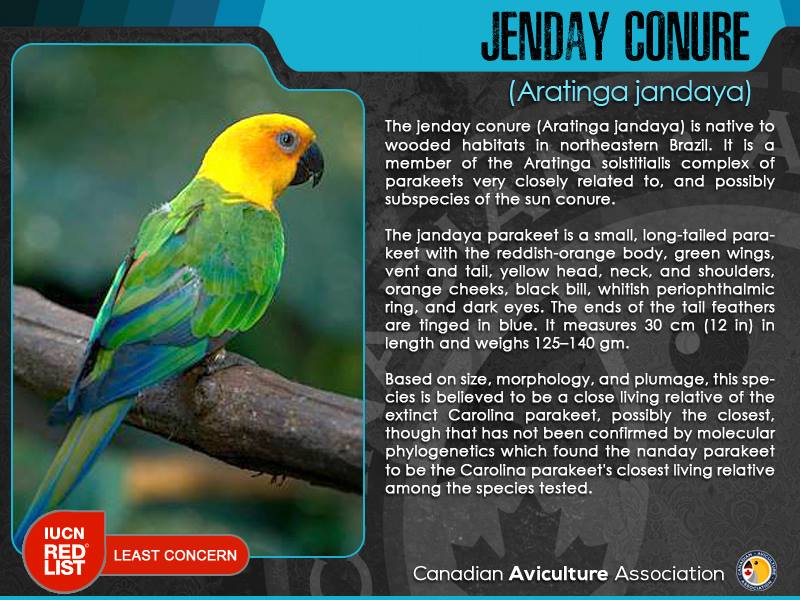Jenday Conure - Aratinga Jandaya - Least Concern
The jandaya parakeet or jenday conure (Aratinga jandaya) is a small Neotropical parrot with green wings and tail, reddish-orange body, yellow head and neck, orange cheeks, and black bill, native to wooded habitats in northeastern Brazil. It is a member of the Aratinga solstitialis complex of parakeets very closely related to, and possibly subspecies of the sun parakeet.
The bird has a wide range, but is locally rare in the wild; they are common in aviculture, where they are known as "jenday conures".
Taxonomy
The taxonomy of this and related species and genera have been problematic
The specific name was derived from: Aratinga: "bright macaw" from Ará – Old Tupi, big noisy bird (macaw) + tinga – Old Tupi, bright. jandaya (originally jandaia): Old Tupi, small parrot (conure).
Jandaya is a member of the Aratinga solstitialis complex of parakeets very closely related to, and possibly subspecies of, the sun parakeet in genus Aratinga of smaller parakeets, one of numerous genera of New World, long-tailed parrots in tribe Arini, which also includes the Central and South American macaws. Tribe Arini together with the Amazonian parrots and a few miscellaneous generals make up subfamily Arinae of Neotropical parrots in family Psittacidae of true parrots.
Based on size, morphology, and plumage, this species is believed to be a close living relative of the extinct Carolina parakeet, possibly the closest, though that has not been confirmed by molecular phylogenetics which found the nanday parakeet to be the Carolina parakeet's closest living relative among the species tested. The plumage of this bird is very close to that of the Carolina's and can be distinguished from the Carolina parakeet by having a yellow neck and shoulders, and a black beak instead of a buff-colored beak as the Carolina parakeet had.
An earlier molecular study found the jandaya's closest relative to be the golden parakeet.
Description
The jandaya parakeet is a small, long-tailed parakeet with the reddish-orange body, green wings, vent and tail, yellow head, neck, and shoulders, orange cheeks, black bill, whitish periophthalmic ring, and dark eyes. The ends of the tail feathers are tinged in blue. It measures 30 cm (12 in) in length and weighs 125–140 gm.
The jandaya parakeet has a very loud, shrill call.
Distribution and Habitat
It has an extremely large range in northeastern Brazil in the states of Piaui, Maranhao, Tocantins, and Ceara, and portions of Pará. It is found in lowland deciduous woodland and palm groves.
Behavior and Diet
In the wild, it has a predilection for various fruits including mango and cashew apples, as well as palm nuts, and an unfortunate attraction to plants cultivated by humans (rice, maize, members of the family Annonaceae, etc.). Things that are toxic to jandaya parakeets include chocolate, caffeine, and a chemical often found in avocados.
Jandaya parakeets nest in tree hollows, typically choosing a location at least 15 m (50 feet) from the ground. In captivity, the hen lays three to six eggs, which she then incubates for roughly 26 days. The young are fed by both parents, and fledge after two months.
Aviculture
This bird is sometimes called, rather colloquially, yellow-headed conure or flaming conure.
The jandaya parakeet can live 30 years in captivity. Like many of the parakeet species commonly kept as companion parrots, jandaya parakeets are known for their intelligence, and can be trained to perform pet-like behaviors. These small parrots can often learn to mimic sounds including words and even phrases.
Jandaya parakeets are social and generally stay in flocks. They are very loud and call to each other frequently.

Psittaciformes, The Parrot Index, a part of Phoenix Feathers © 2016 - 2023
Page last updated: 12/24/23
Phoenix Feathers

